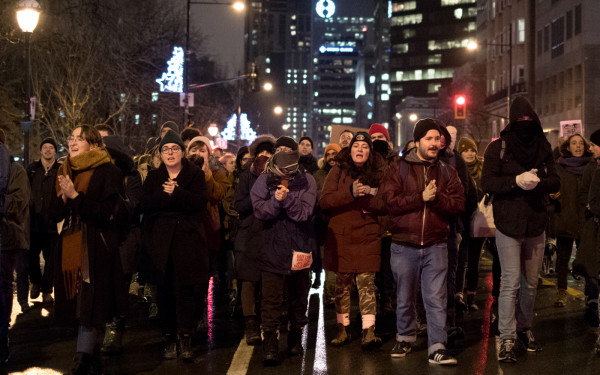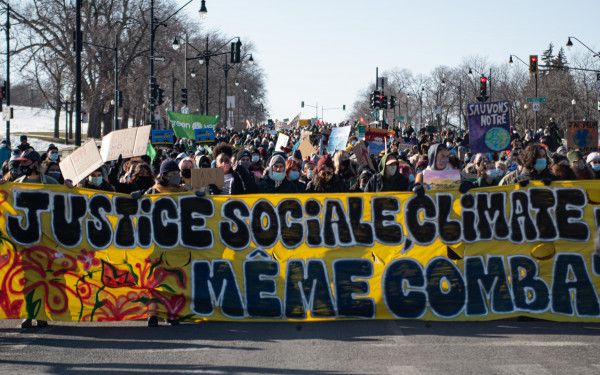Piping Hot Resistance
Fundraiser Seeks to Support Indigenous Resistance to Oil Pipelines
Activists “piped up” Saturday night to raise awareness about the Energy East Pipeline and fundraise for the Unist’ot’en Camp, a hotbed of grassroots resistance fighting for indigenous peoples’ right to their land in British Columbia.
Located in a small studio on de Gaspé Ave., the guests of “Pipe-Up!” were invited to walk in socks and drink Kombucha as they explored a photography project based on a Unist’ot’en documentary and listened to musical performances.
It can be hard for people to feel that they have the power to change things, said activist Alyssa Simon-Bélanger. “That’s why creating events based on creativity and positivity is important—it makes it easy for people to join.”
Samuel Brière, an organizer of the event, explained that the goal was to raise as much money as possible for the Unist’ot’en Camp.
“But beyond that, it’s creating a bridge between what’s going on in BC—the pipeline issues, the tar sands, transportation, etc.—and what we’re facing here in Quebec with the Energy East Project,” he added.TransCanada predicts that the Energy East Pipeline project will be actively pumping oil into Quebec by 2018 if they get final regulatory approval in the fourth quarter of this year.
Simultaneously, TransCanada is looking to build new pipelines on the Wet’suwet’en territory, a free territory that never ceded to the colonial Canadian state, according to the Unist’ot’en Camp website.
This distresses many indigenous people living on the land. A short video documentary projected during the Pipe-Up event called “How to Stop an Oil and Gas Pipeline: The Unist’ot’en Camp Resistance,” explores the many attempts they undertake to protect their land, such as building an oversized streamer with “No Pipelines” written in capital letters, hung between tall trees on the outskirts of the forest.
“Job creation is really not important if the primordial things in life are not being respected,” said Élisabeth Néron.
TransCanada’s East Energy Pipeline website has a section at the top called “Benefits.” With the touch of the mouse, the category expands in four subsections: “Fueling our Growth,” “Creates Jobs,” “Bolsters Provincial Economics” and “Supports Communities.”
The benefits they bring up are mostly related to the economy.
“It might be good [economically] in the short term,” Brière told The Link, adding that in “the long run, we’ll be facing a big wall with exploiting dirty energies.
“Environmentally, socially and economically speaking, it doesn’t make sense.”
According to The Ontario Energy Board’s (OEB) assessment of TransCanada’s Energy East Application, further information is needed to ascertain the effects the pipeline would have, including “with respect to impacts on drinking water.”
The issue is “we’re not using our resources well,” said Alexandra Pronovost, an intellectual and cultural mediator for Exeko, an organization mandated to “promote the inclusion and development of the most marginalized people through innovation in culture and education.”“We all need clean air and clean water, so whatever our differences […] there is a condition of life that we have in common.”
Pronovost emphasized that the event was mostly created to raise awareness.
“Environmental issues […] bring people together. Everyone’s connecting.”
The event provided some information on the ongoing concerns felt by some people towards TransCanada’s pipeline projects. A whole wall was dedicated to a series of pictures taken from the documentary “Line in the Sand; The Unist’ot’en’s Call to the Land,” created by Simple Matters Films. A quote was taped to each picture, giving insight on the film to anyone interested.
The main source of information was the documentary, made by AJ+, an affiliate of Al Jazeera, which focused on the Unist’ot’en Camp. The activists of the indigenous land are shown struggling to be heard.
The first message that appears on screen is, “Since 2010, the Unist’ot’en group, an indigenous group, has been blocking oil and gas pipelines from being built on their land.
“In June 2014, Canada approved the Enbridge Northern Gateway, a tar sands pipeline, and gave them 209 conditions to fulfill.
“One of those conditions is a mandatory consultation with the indigenous communities whose land they would cross.”
The gatewayfacts.ca website states that one of five conditions to building the pipeline is to make sure that the “legal requirements regarding Aboriginal and treaty rights are addressed, and First Nations are provided with the opportunities, information and resources necessary to participate in and benefit from a heavy oil project.”
Pronovost explained that indigenous people have a right to choose whether the pipeline runs through their land or not. “It’s their land; they have to decide if they want it to go there,” she said. Pronovost added that until we leave indigenous peoples alone to decide what they want to do with their resources, we’re are still in a “colonialist racist system.”
“You can try to disguise it under fancy words, but that’s kind of what it boils down to.”
Correction: The photography project was not from the documentary Resist, rather from the documentary Line In The Sand.

1_900_600_90.jpg)
2_900_600_90.jpg)
3_900_600_90.jpg)
_600_832_s.png)




